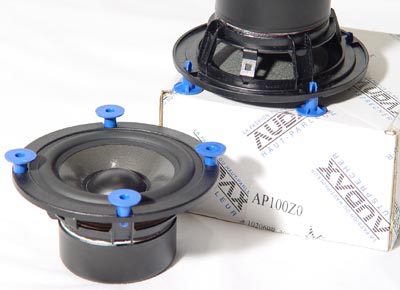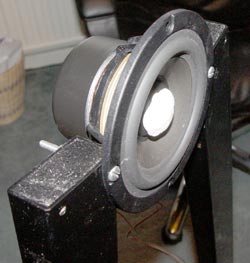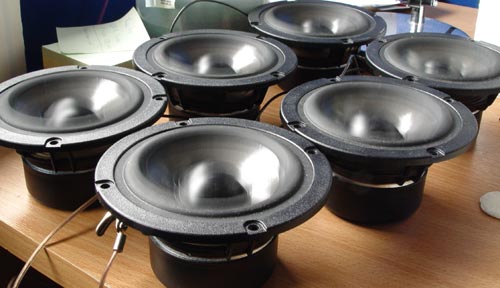|
This design was born from the cheap availability of Audax AP100Z0 drivers. A Maplin close-out
saw these 4" drivers sell for £4.98 each (1/3 of their usual price), which begged to be taken advantage of.
I bought six drivers with the tweeter undecided.
Audax AP100Z0

This 4" bass/midrange speaker has been designed to a high specification and manufactured to exceptional quality. It features a non-resonant high impact polymer chassis, a high temperature voice coil and a built in cosmetic ring designed for front-rear and recessed mounting. It also has a fully shielded magnet system making it ideal for all audio video applications. This speaker features an HDA (High Definition Aerogel) cone with high loss rubber surround.

To measure the drivers, they are fixed to my dedicated measuring clamp and the impedance plot is taken with the aid of Speaker Workshop (SW) and
the Wallin Jig II.
VAS is calculated using the added mass method with 3.56g (weighed against a 1p coin) of blu-tac stuck to the dustcap.
The following parameters are provided:
| Re |
5.7 ohms |
DMM |
| Sd |
52 cm2 |
Audax |
| Sens. |
84.7 db W/M |
Audax |
| Pe |
30 W |
Audax |
| xmax |
2.7 mm |
Audax |
Breaking the drivers in

The following shows the average T/S parameters from the measured drivers calculated after different periods of breaking-in, and compared to
the specs provided by Audax. Breaking-in is done using 15Hz and 20Hz test tones running the drivers to xmax or mechanical excursion.
| 0 Hours |
92.5 |
2.18 |
2.93 |
0.95 |
0.71 |
0.16 |
0.29 |
14.1 |
| 30 Hours |
85.4 |
2.52 |
2.84 |
0.86 |
0.66 |
0.16 |
0.29 |
13.9 |
| 50 Hours |
79.8 |
2.81 |
2.63 |
0.83 |
0.63 |
0.16 |
0.30 |
14.2 |
| 70 Hours |
79.6 |
2.85 |
2.63 |
0.81 |
0.62 |
0.16 |
0.30 |
14.2 |
| Audax |
64.0 |
4.72 |
2.16 |
0.63 |
0.49 |
0.45 |
|
|
| Difference * |
20% |
40% |
18% |
22% |
21% |
64% |
|
|
* between break-in results and manufacturer specs. Note figures are rounded.
At first glance the results show a large difference between measured and manufacturer specs. A look at the most important specs: Fs, VAS and Qts, shows
that VAS is the only parameter outside an acceptable 30% tolerance.
|